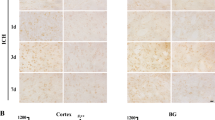Summary
Pretreatment with low-dose thrombin attenuates brain edema induced by iron or intracerebral hemorrhage (ICH). Ceruloplasmin is involved in iron metabolism by oxidizing ferrous iron to ferric iron. The present study examines whether thrombin modulates brain ceruloplasmin levels and whether exogenous ceruloplasmin reduces brain edema induced by ferrous iron in vivo.
In the first set of experiments, rats received intracerebral infusion of saline or 1 U thrombin into the right basal ganglia. Rats were killed 1, 3, or 7 days later for Western blot analysis and RT-PCR analysis. In the second set of experiments, rats received either ferric iron, ferrous iron, or ferrous iron plus ceruloplasmin, then were killed 24 hours later for brain edema measurement. We found that ceruloplasmin protein levels in the ipsilateral basal ganglia increased on the first day after thrombin stimulation and peaked at day 3. Brain ceruloplasmin levels were higher after thrombin infusion than after saline injection. RT-PCR showed that brain ceruloplasmin mRNA levels were also up-regulated after thrombin injection (p<0.05). We also found ipsilateral brain edema after intracerebral infusion of ferrous iron but not ferric iron at 24 hours. Co-injection of ferrous iron with ceruloplasmin reduced ferrous iron-induced brain edema (p<0.05). Our results demonstrate that thrombin increases brain ceruloplasmin levels and exogenous ceruloplasmin reduces ferrous iron-induced brain edema, suggesting that ceruloplasmin up-regulation may contribute to thrombin-induced brain tolerance to ICH by limiting the injury caused by ferrous iron released from the hematoma.
Access this chapter
Tax calculation will be finalised at checkout
Purchases are for personal use only
Preview
Unable to display preview. Download preview PDF.
Similar content being viewed by others
References
Hahn P, Qian Y, Dentchev T, Chen L, Beard J, Harris ZL, Dunaief JL (2004) Disruption of ceruloplasmin and hephaestin in mice causes retinal iron overload and retinal degeneration with features of age-related macular degeneration. Proc Natl Acad Sci USA 101: 13850–13855
Hua Y, Xi G, Keep RF, Wu J, Jiang Y, Hoff JT (2002) Plasminogen activator inhibitor-1 induction after experimental intracerebral hemorrhage. J Cereb Blood Flow Metab 22: 55–61
Hua Y, Keep RF, Hoff JT, Xi G (2003) Thrombin preconditioning attenuates brain edema induced by erythrocytes and iron. J Cereb Blood Flow Metab 23: 1448–1454
Huang F, Xi G, Keep RF, Hua Y, Nemoianu A, Hoff JT (2002) Brain edema after experimental intracerebral hemorrhage: role of hemoglobin degradation products. J Neurosurg 96: 287–293
Jeong SY, David S (2003) Glycosylphosphatidylinositolanchored ceruloplasmin is required for iron effux from cells in the central nervous system. J Biol Chem 278: 27144–27148
Jiang Y, Wu J, Hua Y, Keep RF, Xiang J, Hoff JT, Xi G (2002) Thrombin-receptor activation and thrombin-induced brain tolerance. J Cereb Blood Flow Metab 22: 404–410
Klomp LWJ, Farhangrazi ZS, Dugan LL, Gitlin JD (1996) Ceruloplasmin gene expression in the murine central nervous system. J Clin Invest 98: 207–215
Masada T, Xi G, Hua Y, Keep RF (2000) The effects of thrombin preconditioning on focal cerebral ischemia in rats. Brain Res 867: 173–179
Nakamura T, Keep R, Hua Y, Schallert T, Hoff J, Xi G (2004) Deferoxamine-induced attenuation of brain edema and neurological deficits in a rat model of intracerebral hemorrhage. J Neurosurg 100: 672–678
Patel BN, Dunn RJ, Jeong SY, Zhu Q, Julien JP, David S (2002) Ceruloplasmin regulates iron levels in the CNS and prevents free radical injury. J Neurosci 22: 6578–6586
Qian ZM, Wang Q (1998) Expression of iron transport proteins and excessive iron accumulation in the brain in neurodegenerative disorders. Brain Res Rev 27: 257–267
Thompson KJ, Shoham S, Connor JR (2001) Iron and neurodegenerative disorders. Brain Res Bull 55: 155–164
Vaughan PJ, Pike CJ, Cotman CW, Cunningham DD (1995) Thrombin receptor activation protects neurons and astrocytes from cell death produced by environmental insults. J Neurosci 15: 5389–5401
Wu J, Hua Y, Keep RF, Nakamura T, Hoff JT, Xi G (2003) Iron and iron-handling proteins in the brain after intracerebral hemorrhage. Stroke 34: 2964–2969
Xi G, Keep RF, Hoff JT (1998) Erythrocytes and delayed brain edema formation following intracerebral hemorrhage in rats. J Neurosurg 89: 991–996
Xi G, Keep RF, Hua Y, Xiang JM, Hoff JT (1999) Attenuation of thrombin-induced brain edema by cerebral thrombin preconditioning. Stroke 30: 1247–1255
Xi G, Hua Y, Keep RF, Hoff JT (2000) Induction of colligin may attenuate brain edema following intracerebral hemorrhage. Acta Neurochir Suppl 76: 501–505
Xi G, Fewel ME, Hua Y, Thompson BG, Hoff J, Keep R (2004) Intracerebral hemorrhage: pathophysiology and therapy. Neurocrit Care 1: 5–18
Zhang Y, Pardridge WM (2001) Rapid transferrin efflux from brain to blood across the blood-brain barrier. J Neurochem 76:1597–1600
Author information
Authors and Affiliations
Editor information
Editors and Affiliations
Rights and permissions
Copyright information
© 2006 Springer-Verlag
About this paper
Cite this paper
Yang, S., Hua, Y., Nakamura, T., Keep, R.F., Xi, G. (2006). Up-regulation of brain ceruloplasmin in thrombin preconditioning. In: Hoff, J.T., Keep, R.F., Xi, G., Hua, Y. (eds) Brain Edema XIII. Acta Neurochirurgica Supplementum, vol 96. Springer, Vienna. https://doi.org/10.1007/3-211-30714-1_44
Download citation
DOI: https://doi.org/10.1007/3-211-30714-1_44
Publisher Name: Springer, Vienna
Print ISBN: 978-3-211-30712-0
Online ISBN: 978-3-211-30714-4
eBook Packages: MedicineMedicine (R0)



